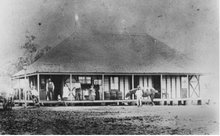One of the treasures of the Rosewood Scrub is its historical society (RSHS). Located in what else but a historical building in downtown Marburg, it is staffed by a small group of dedicated volunteers. In addition to the hall itself, there is also a restored dairy. I am always surprised by how small the dairy is. I would like to take a closer look another time as I have wondered how a cow actually fitted in there, or did you milk outside and just use it for storage? I’m sure that someone there could tell me, or I could look at their online publication Dairying in the Rosewood Scrub.
The dedication of these volunteers is such that two Sunday afternoons a month, they are open to the public to answer questions and allow browsing. Hence, my Sunday afternoon yesterday was spent very pleasantly having a look around the archives and chatting to the two volunteers of the day.
I was a bit like a chocoholic in a lolly shop. I didn’t really know where to start so I looked at the impressive display of photographs. The society has recently completed copying, archiving and safely storing all their historical photographs and reproducing a selection for public display. Many of the photographs were of prominent locals. After all, the main quest for many visitors is family history. For me, the most interesting photographs were of the early farms, buildings and vistas.
In order to focus my research, I am looking at the time when most German settlement seemed to occur – that is, the 1870s and 1880s. From my brief examination of archival material yesterday, it amazed me how quickly the land was cleared and settled. In 1876, the earliest known photograph of Marburg was taken. In the same year, J.L. Frederick who had left Prussia in 1866 was making a formal application for a state school to be established at “Sally Owen’s Plain” in the Rosewood Scrub. Though not in the same location, this school is attended by my children today.
By 1887, advertisement for established farms were appearing in the Queensland Times. One such advertisement on August 9, 1887 read:
"42 acres under plough, permanent dam and an underground tank. There is a comfortable dwelling and two iron tanks -- The property is securely fenced and subdivided –- The land will grow anything." W.M. Haigh and Co. Auction.
This answers one question for me. Farmers did have tanks for water at quite an early stage in addition to dams.
I think that the State Library will be most important for newspaper archives and government records. However, it looks as if the RSHS will be a valuable resource for personal records, photographs and collections of research by local historians.
Subscribe to:
Post Comments (Atom)

No comments:
Post a Comment